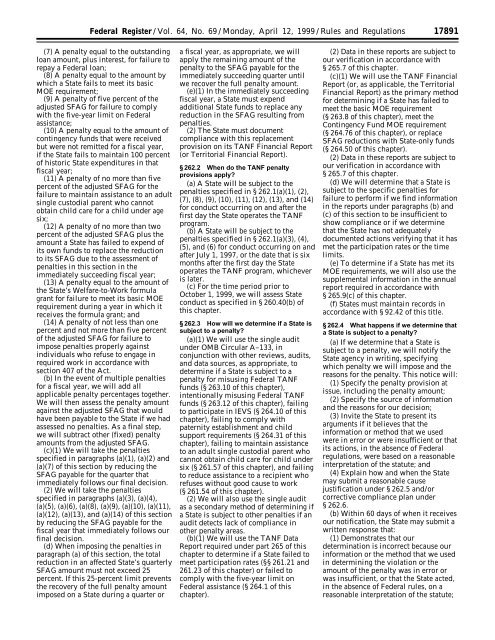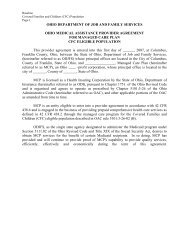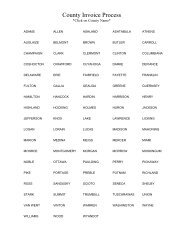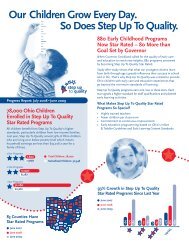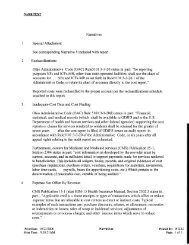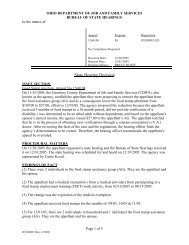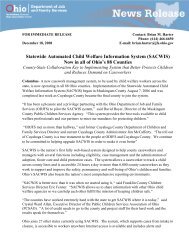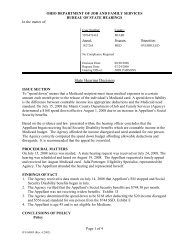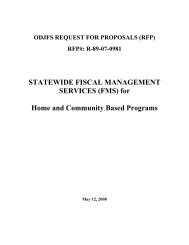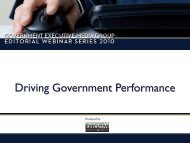Final TANF Rule as published in the Federal Register 4/12/1999
Final TANF Rule as published in the Federal Register 4/12/1999
Final TANF Rule as published in the Federal Register 4/12/1999
Create successful ePaper yourself
Turn your PDF publications into a flip-book with our unique Google optimized e-Paper software.
<strong>Federal</strong> <strong>Register</strong> / Vol. 64, No. 69 / Monday, April <strong>12</strong>, <strong>1999</strong> / <strong>Rule</strong>s and Regulations<br />
(7) A penalty equal to <strong>the</strong> outstand<strong>in</strong>g<br />
loan amount, plus <strong>in</strong>terest, for failure to<br />
repay a <strong>Federal</strong> loan;<br />
(8) A penalty equal to <strong>the</strong> amount by<br />
which a State fails to meet its b<strong>as</strong>ic<br />
MOE requirement;<br />
(9) A penalty of five percent of <strong>the</strong><br />
adjusted SFAG for failure to comply<br />
with <strong>the</strong> five-year limit on <strong>Federal</strong><br />
<strong>as</strong>sistance;<br />
(10) A penalty equal to <strong>the</strong> amount of<br />
cont<strong>in</strong>gency funds that were received<br />
but were not remitted for a fiscal year,<br />
if <strong>the</strong> State fails to ma<strong>in</strong>ta<strong>in</strong> 100 percent<br />
of historic State expenditures <strong>in</strong> that<br />
fiscal year;<br />
(11) A penalty of no more than five<br />
percent of <strong>the</strong> adjusted SFAG for <strong>the</strong><br />
failure to ma<strong>in</strong>ta<strong>in</strong> <strong>as</strong>sistance to an adult<br />
s<strong>in</strong>gle custodial parent who cannot<br />
obta<strong>in</strong> child care for a child under age<br />
six;<br />
(<strong>12</strong>) A penalty of no more than two<br />
percent of <strong>the</strong> adjusted SFAG plus <strong>the</strong><br />
amount a State h<strong>as</strong> failed to expend of<br />
its own funds to replace <strong>the</strong> reduction<br />
to its SFAG due to <strong>the</strong> <strong>as</strong>sessment of<br />
penalties <strong>in</strong> this section <strong>in</strong> <strong>the</strong><br />
immediately succeed<strong>in</strong>g fiscal year;<br />
(13) A penalty equal to <strong>the</strong> amount of<br />
<strong>the</strong> State’s Welfare-to-Work formula<br />
grant for failure to meet its b<strong>as</strong>ic MOE<br />
requirement dur<strong>in</strong>g a year <strong>in</strong> which it<br />
receives <strong>the</strong> formula grant; and<br />
(14) A penalty of not less than one<br />
percent and not more than five percent<br />
of <strong>the</strong> adjusted SFAG for failure to<br />
impose penalties properly aga<strong>in</strong>st<br />
<strong>in</strong>dividuals who refuse to engage <strong>in</strong><br />
required work <strong>in</strong> accordance with<br />
section 407 of <strong>the</strong> Act.<br />
(b) In <strong>the</strong> event of multiple penalties<br />
for a fiscal year, we will add all<br />
applicable penalty percentages toge<strong>the</strong>r.<br />
We will <strong>the</strong>n <strong>as</strong>sess <strong>the</strong> penalty amount<br />
aga<strong>in</strong>st <strong>the</strong> adjusted SFAG that would<br />
have been payable to <strong>the</strong> State if we had<br />
<strong>as</strong>sessed no penalties. As a f<strong>in</strong>al step,<br />
we will subtract o<strong>the</strong>r (fixed) penalty<br />
amounts from <strong>the</strong> adjusted SFAG.<br />
(c)(1) We will take <strong>the</strong> penalties<br />
specified <strong>in</strong> paragraphs (a)(1), (a)(2) and<br />
(a)(7) of this section by reduc<strong>in</strong>g <strong>the</strong><br />
SFAG payable for <strong>the</strong> quarter that<br />
immediately follows our f<strong>in</strong>al decision.<br />
(2) We will take <strong>the</strong> penalties<br />
specified <strong>in</strong> paragraphs (a)(3), (a)(4),<br />
(a)(5), (a)(6), (a)(8), (a)(9), (a)(10), (a)(11),<br />
(a)(<strong>12</strong>), (a)(13), and (a)(14) of this section<br />
by reduc<strong>in</strong>g <strong>the</strong> SFAG payable for <strong>the</strong><br />
fiscal year that immediately follows our<br />
f<strong>in</strong>al decision.<br />
(d) When impos<strong>in</strong>g <strong>the</strong> penalties <strong>in</strong><br />
paragraph (a) of this section, <strong>the</strong> total<br />
reduction <strong>in</strong> an affected State’s quarterly<br />
SFAG amount must not exceed 25<br />
percent. If this 25-percent limit prevents<br />
<strong>the</strong> recovery of <strong>the</strong> full penalty amount<br />
imposed on a State dur<strong>in</strong>g a quarter or<br />
a fiscal year, <strong>as</strong> appropriate, we will<br />
apply <strong>the</strong> rema<strong>in</strong><strong>in</strong>g amount of <strong>the</strong><br />
penalty to <strong>the</strong> SFAG payable for <strong>the</strong><br />
immediately succeed<strong>in</strong>g quarter until<br />
we recover <strong>the</strong> full penalty amount.<br />
(e)(1) In <strong>the</strong> immediately succeed<strong>in</strong>g<br />
fiscal year, a State must expend<br />
additional State funds to replace any<br />
reduction <strong>in</strong> <strong>the</strong> SFAG result<strong>in</strong>g from<br />
penalties.<br />
(2) The State must document<br />
compliance with this replacement<br />
provision on its <strong>TANF</strong> F<strong>in</strong>ancial Report<br />
(or Territorial F<strong>in</strong>ancial Report).<br />
§ 262.2 When do <strong>the</strong> <strong>TANF</strong> penalty<br />
provisions apply?<br />
(a) A State will be subject to <strong>the</strong><br />
penalties specified <strong>in</strong> § 262.1(a)(1), (2),<br />
(7), (8), (9), (10), (11), (<strong>12</strong>), (13), and (14)<br />
for conduct occurr<strong>in</strong>g on and after <strong>the</strong><br />
first day <strong>the</strong> State operates <strong>the</strong> <strong>TANF</strong><br />
program.<br />
(b) A State will be subject to <strong>the</strong><br />
penalties specified <strong>in</strong> § 262.1(a)(3), (4),<br />
(5), and (6) for conduct occurr<strong>in</strong>g on and<br />
after July 1, 1997, or <strong>the</strong> date that is six<br />
months after <strong>the</strong> first day <strong>the</strong> State<br />
operates <strong>the</strong> <strong>TANF</strong> program, whichever<br />
is later.<br />
(c) For <strong>the</strong> time period prior to<br />
October 1, <strong>1999</strong>, we will <strong>as</strong>sess State<br />
conduct <strong>as</strong> specified <strong>in</strong> § 260.40(b) of<br />
this chapter.<br />
§ 262.3 How will we determ<strong>in</strong>e if a State is<br />
subject to a penalty?<br />
(a)(1) We will use <strong>the</strong> s<strong>in</strong>gle audit<br />
under OMB Circular A–133, <strong>in</strong><br />
conjunction with o<strong>the</strong>r reviews, audits,<br />
and data sources, <strong>as</strong> appropriate, to<br />
determ<strong>in</strong>e if a State is subject to a<br />
penalty for misus<strong>in</strong>g <strong>Federal</strong> <strong>TANF</strong><br />
funds (§ 263.10 of this chapter),<br />
<strong>in</strong>tentionally misus<strong>in</strong>g <strong>Federal</strong> <strong>TANF</strong><br />
funds (§ 263.<strong>12</strong> of this chapter), fail<strong>in</strong>g<br />
to participate <strong>in</strong> IEVS (§ 264.10 of this<br />
chapter), fail<strong>in</strong>g to comply with<br />
paternity establishment and child<br />
support requirements (§ 264.31 of this<br />
chapter), fail<strong>in</strong>g to ma<strong>in</strong>ta<strong>in</strong> <strong>as</strong>sistance<br />
to an adult s<strong>in</strong>gle custodial parent who<br />
cannot obta<strong>in</strong> child care for child under<br />
six (§ 261.57 of this chapter), and fail<strong>in</strong>g<br />
to reduce <strong>as</strong>sistance to a recipient who<br />
refuses without good cause to work<br />
(§ 261.54 of this chapter).<br />
(2) We will also use <strong>the</strong> s<strong>in</strong>gle audit<br />
<strong>as</strong> a secondary method of determ<strong>in</strong><strong>in</strong>g if<br />
a State is subject to o<strong>the</strong>r penalties if an<br />
audit detects lack of compliance <strong>in</strong><br />
o<strong>the</strong>r penalty are<strong>as</strong>.<br />
(b)(1) We will use <strong>the</strong> <strong>TANF</strong> Data<br />
Report required under part 265 of this<br />
chapter to determ<strong>in</strong>e if a State failed to<br />
meet participation rates (§§ 261.21 and<br />
261.23 of this chapter) or failed to<br />
comply with <strong>the</strong> five-year limit on<br />
<strong>Federal</strong> <strong>as</strong>sistance (§ 264.1 of this<br />
chapter).<br />
17891<br />
(2) Data <strong>in</strong> <strong>the</strong>se reports are subject to<br />
our verification <strong>in</strong> accordance with<br />
§ 265.7 of this chapter.<br />
(c)(1) We will use <strong>the</strong> <strong>TANF</strong> F<strong>in</strong>ancial<br />
Report (or, <strong>as</strong> applicable, <strong>the</strong> Territorial<br />
F<strong>in</strong>ancial Report) <strong>as</strong> <strong>the</strong> primary method<br />
for determ<strong>in</strong><strong>in</strong>g if a State h<strong>as</strong> failed to<br />
meet <strong>the</strong> b<strong>as</strong>ic MOE requirement<br />
(§ 263.8 of this chapter), meet <strong>the</strong><br />
Cont<strong>in</strong>gency Fund MOE requirement<br />
(§ 264.76 of this chapter), or replace<br />
SFAG reductions with State-only funds<br />
(§ 264.50 of this chapter).<br />
(2) Data <strong>in</strong> <strong>the</strong>se reports are subject to<br />
our verification <strong>in</strong> accordance with<br />
§ 265.7 of this chapter.<br />
(d) We will determ<strong>in</strong>e that a State is<br />
subject to <strong>the</strong> specific penalties for<br />
failure to perform if we f<strong>in</strong>d <strong>in</strong>formation<br />
<strong>in</strong> <strong>the</strong> reports under paragraphs (b) and<br />
(c) of this section to be <strong>in</strong>sufficient to<br />
show compliance or if we determ<strong>in</strong>e<br />
that <strong>the</strong> State h<strong>as</strong> not adequately<br />
documented actions verify<strong>in</strong>g that it h<strong>as</strong><br />
met <strong>the</strong> participation rates or <strong>the</strong> time<br />
limits.<br />
(e) To determ<strong>in</strong>e if a State h<strong>as</strong> met its<br />
MOE requirements, we will also use <strong>the</strong><br />
supplemental <strong>in</strong>formation <strong>in</strong> <strong>the</strong> annual<br />
report required <strong>in</strong> accordance with<br />
§ 265.9(c) of this chapter.<br />
(f) States must ma<strong>in</strong>ta<strong>in</strong> records <strong>in</strong><br />
accordance with § 92.42 of this title.<br />
§ 262.4 What happens if we determ<strong>in</strong>e that<br />
a State is subject to a penalty?<br />
(a) If we determ<strong>in</strong>e that a State is<br />
subject to a penalty, we will notify <strong>the</strong><br />
State agency <strong>in</strong> writ<strong>in</strong>g, specify<strong>in</strong>g<br />
which penalty we will impose and <strong>the</strong><br />
re<strong>as</strong>ons for <strong>the</strong> penalty. This notice will:<br />
(1) Specify <strong>the</strong> penalty provision at<br />
issue, <strong>in</strong>clud<strong>in</strong>g <strong>the</strong> penalty amount;<br />
(2) Specify <strong>the</strong> source of <strong>in</strong>formation<br />
and <strong>the</strong> re<strong>as</strong>ons for our decision;<br />
(3) Invite <strong>the</strong> State to present its<br />
arguments if it believes that <strong>the</strong><br />
<strong>in</strong>formation or method that we used<br />
were <strong>in</strong> error or were <strong>in</strong>sufficient or that<br />
its actions, <strong>in</strong> <strong>the</strong> absence of <strong>Federal</strong><br />
regulations, were b<strong>as</strong>ed on a re<strong>as</strong>onable<br />
<strong>in</strong>terpretation of <strong>the</strong> statute; and<br />
(4) Expla<strong>in</strong> how and when <strong>the</strong> State<br />
may submit a re<strong>as</strong>onable cause<br />
justification under § 262.5 and/or<br />
corrective compliance plan under<br />
§ 262.6.<br />
(b) With<strong>in</strong> 60 days of when it receives<br />
our notification, <strong>the</strong> State may submit a<br />
written response that:<br />
(1) Demonstrates that our<br />
determ<strong>in</strong>ation is <strong>in</strong>correct because our<br />
<strong>in</strong>formation or <strong>the</strong> method that we used<br />
<strong>in</strong> determ<strong>in</strong><strong>in</strong>g <strong>the</strong> violation or <strong>the</strong><br />
amount of <strong>the</strong> penalty w<strong>as</strong> <strong>in</strong> error or<br />
w<strong>as</strong> <strong>in</strong>sufficient, or that <strong>the</strong> State acted,<br />
<strong>in</strong> <strong>the</strong> absence of <strong>Federal</strong> rules, on a<br />
re<strong>as</strong>onable <strong>in</strong>terpretation of <strong>the</strong> statute;


